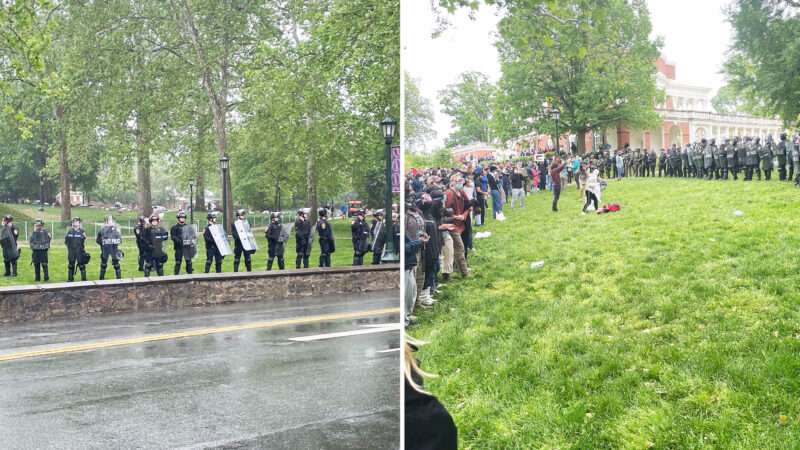
On Saturday, dozens of police officers—many in riot gear—broke up a small pro-Palestine encampment at the University of Virginia.
The tent encampment had formed less than 24 hours prior. According to a letter from UVA President Jim Ryan, protesting students started what they called the "UVA liberation encampment for Gaza" on April 30 but complied with orders not to set up tents, which would violate university policy. However, following rain over Friday night, students put up several tents, leading university police to attempt to remove the encampment.
According to a statement from the university, university and local police arrived around 11:45 a.m. on Saturday to inform protesters that their demonstration was in violation of school policy and directed them to leave. But "police were met with aggression and protesters swung objects at officers. University police then requested the assistance of Virginia State Police to assist in declaring an unlawful assembly."
Controversy has sprung up around the university's tent policy after a section on tent permits that had explicitly exempted "recreational tents for camping" was apparently removed Saturday morning. UVA insists the change wasn't an attempt to entrap protesters.
"University officials said camping tents or other recreational tents are not allowed on University property without permits under a policy that has been in place since 2005," a Sunday statement reads. "However, the permit application—not the policy itself—contained contradictory language," which was edited after a faculty member notified the administration.
When I arrived on UVA's campus at around 1:15 p.m. on Saturday, police had already surrounded the encampment. The number of students actually in the encampment was dwarfed by the crowd that gathered to watch the standoff—a mixture of encampment supporters, pro-Israel counterprotesters, and rubberneckers.
I fell in that last group, jostling to get a good view of the standoff between police and protesters. Most people around me—myself included—spent much of the time recording the spectacle on their phones.
I can't say for sure whether the alleged aggression police were met with earlier in the day justified the police response, but as far as I saw on Saturday, the protest was confined to peaceful civil disobedience. The number of police alone was staggering—a mixture of state, county, city, and university police departments, many in full riot gear and several sporting large rifles. Even if the university was within its rights to break up the encampment, it was hard not to think about how disproportionate it looked.
It's difficult not to assume that the sheer size of the police presence was connected to the chaos and violence that has erupted at colleges like Columbia and UCLA in recent weeks—and UVA's hope to stifle the encampment before it grew unmanageable. However, compared to the mayhem at other universities, UVA's encampment looked incredibly, almost laughably tame.
The same went for the actual content of the protest. While students at Columbia shouted odious (though First Amendment-protected) slogans like "There is only one solution: intifada revolution," the protesters at UVA stayed away from controversial or violence-endorsing messages. All the chants I heard were focused on Gaza and generic support for a free Palestine. At one point, a protester attempted to start a chant of "From the river to the sea, Palestine will be free," but no one joined her.
Regardless, the afternoon was ugly. After pushing protesters away from the actual encampment, police and protesters remained in an extended standoff. Police deployed chemical irritants into the crowd multiple times—spraying enough that area I was standing in was also hit with waves of it, despite being several yards away from the main protest. By the end of the day, 25 protesters were arrested, and the encampment was destroyed.
University administrators are in a genuine bind when it comes to protest encampments on their campuses. For starters, colleges are generally well within their rights to ban tent encampments. "Restrictions on encampments and building occupations generally satisfy the criteria of a legitimate time, place, and manner regulation," writes Jessie Appleby of the Foundation for Individual Rights and Expression (FIRE), a First Amendment group. "Institutions must be able to regulate on-campus expressive activity to ensure it doesn't interfere with their primary educational and scholarly missions."
If a college doesn't respond to a disruptive, prohibited tent encampment, it risks setting a precedent that incentivizes students to indefinitely take over patches of campus in protest. (Plus, it risks its president getting hauled before Congress.) If it responds too harshly, it creates a scene like the one at UVA, where police presence eclipses peaceful protesters and makes university leadership look like rank bullies.
At UVA, the administration seems to have gotten what they wanted—at least for now. As of Sunday, protests have begun again. This time, without the tents.
The post What I Saw at the University of Virginia's Protest Crackdown appeared first on Reason.com.







